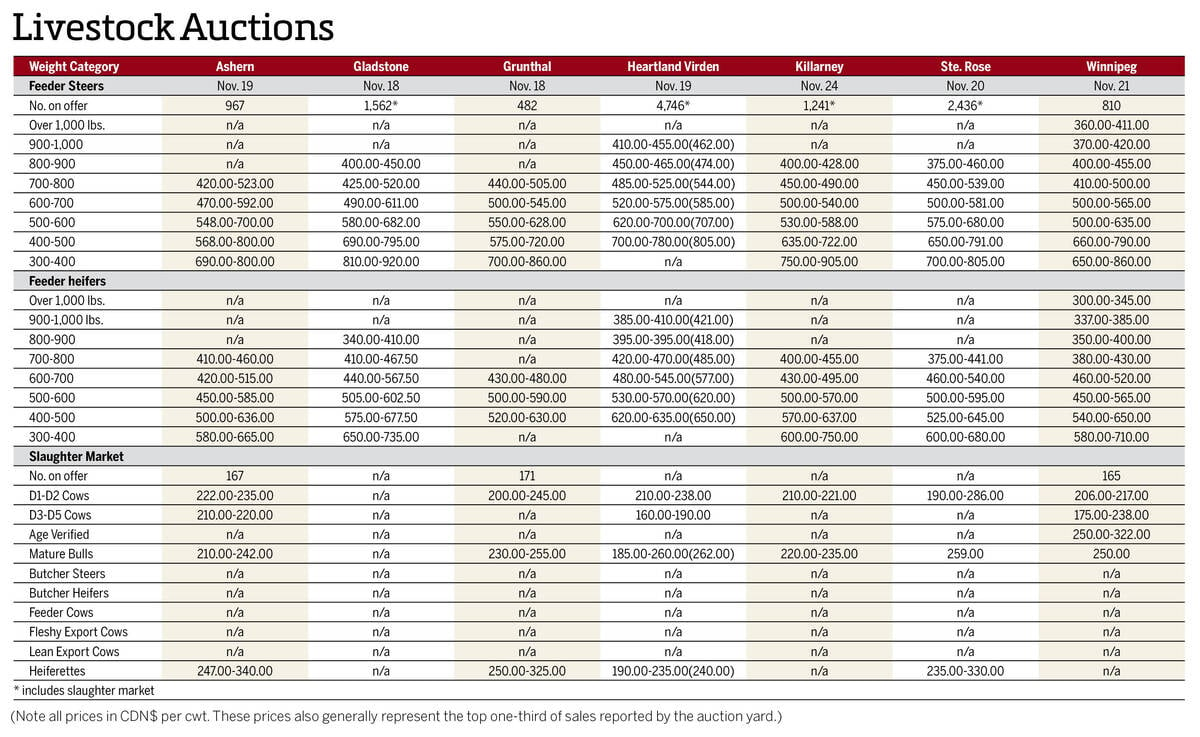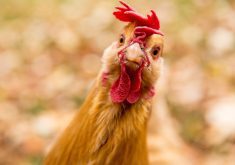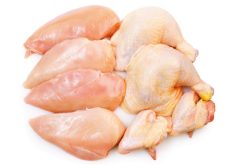It didn’t get much attention when U.S. President Joe Biden launched a biomanufacturing initiative last September.
But it should have. Biomanufacturing is about harnessing nature’s factories – cells – to make just about anything. That includes food. As Biden pointed out, biomanufacturing could boost food security.
How? By cultivating meat. Having a roast for dinner has traditionally required rearing animals, slaughtering them, and discarding inedible parts. But technology has advanced to the point we can now grow animal muscle cells in bioreactors.
Read Also

Manitoba cattle prices – Nov. 24
Cattle prices from Manitoba’s major auction marts for the week of Nov. 18-24.
Cultivated meat has come a long way, but it’s still not cost-competitive with traditional meat. The last hurdle to be overcome is scale.
To create a new farm, you have to remove most of what was there before – forests, grasslands, wetlands. Cows, sheep, chickens and pigs are hungry, so the demand for soybeans and other feed shoots up. And cows belch out methane from the fermenting grass in their stomachs. Animal agriculture contributes nearly 15 per cent of the world’s emissions – and cows make up the largest share of that.
While growing and eating plants directly is still the most calorie efficient way to produce food, many people who have grown up eating meat are unlikely to switch to fully vegetarian diets. The taste and texture of animal muscle and fat tissue just can’t be fully replicated by plant proteins and oils.
Cattle are more sensitive to temperatures than humans, especially to heat. They can’t get rid of as much heat by sweating. They prefer temperatures below 20 C. During heatwaves, they can suffer heat stress, which can lead to organ failure and death.
Cultivated meat is done indoors in temperature-controlled areas. It also allows us to farm vertically, creating a smaller footprint. Beef produced this way requires vastly less land (95 per cent less) and with a fraction of the greenhouse gases (92 per cent less) than traditional beef production, according to a life cycle analysis.
There’s also much less waste. If you want to be able to cook and eat chicken breast and thighs, why not just grow those parts rather than breeding and raising a chicken, complete with digestive tract, brain and feathers?
Biopsied muscle cells from chickens can be grown inside bioreactors, sterile stainless-steel tanks. Another bonus is you don’t need to rely on antibiotics.
Importantly, these muscle and fat cells floating in a broth of plant-based nutrients (called culture medium) promise to be much better at converting food into muscle mass. For every three calories of broth, we could get one calorie of meat in return.
Chickens convert food to meat at an 8:1 ratio. But cows need much more. For every approximately 30 calories of feed a cow eats, we get one calorie of food in return.
Their ceaseless demand for food is the main driver of the destruction of tropical forests. Two-fifths of all tropical deforestation is to make more pastures for cows, with 18 per cent of this deforestation done to plant oilseeds like soybeans, most of which become cattle food.
In 2013, the world saw the first ever burger made from cultivated meat. It cost C$467,000. Investment poured in and the cost plunged. By 2017, advocates were predicting cost parity with traditional meat within five years.
It’s 2023, so where is it? While some products are getting closer, they’re still not cheaper than traditional meat. Skeptics argue the technological barriers are insurmountable.
There’s some merit to this critique. Scale is the hardest step for any new technology. Many cultivated meat companies have succeeded in the laboratory, but none have gone all the way to commercial scale.
There are still issues to iron out, such as ensuring bioreactors stay sterile at large scales, and navigating food regulations. Last year’s economic turbulence has also seen private investment drop, though public investment has risen.
Small, high-tech countries like Singapore and Israel are leaders in this area. Both nations are acutely aware of their climate vulnerabilities and dependence on food imports.
Singapore imports 90 per cent of its food, for instance. This is why they’re looking at cultivated meat as well as other alternative proteins. Two years ago, Singapore became the first place in the world where you can actually buy cultivated meat.
This didn’t just happen. It invested in talent, streamlined regulations and actively set out to attract companies.
Growing cells in culture has been done for decades in biomedical research. What’s new is applying this biotech knowledge to food.
Is it a threat to farmers? Not necessarily. Diversifying into new protein markets – as U.S. beef giants like Cargill are doing – could help farmers and agribusinesses stay competitive.
We’ll need a combination of private and public investment to overcome the remaining technical and financial barriers to scale.
As we face an increasingly uncertain future, it might be a smart move to secure our food supply while protecting ourselves against climate change and reducing environmental damage.
– Bianca Le is a cell biologist and Honorary Fellow in Agriculture and Food at the University of Melbourne.















